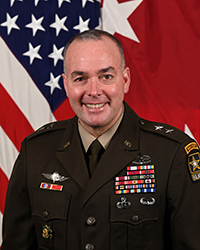LEADERS
MISSION
Public affairs fulfills the Army's obligation to keep the American people and the Army informed, and helps to establish the conditions that lead to confidence in America's Army and its readiness to conduct operations in peacetime, conflict and war.
What is Army Public Affairs?
Army Public Affairs is comprised of Soldiers and Officers adept at planning and executing a commander’s communication strategy through corporate communication, media and stakeholder engagements, and community outreach activities directed toward external and internal publics with interest in the Department of Defense. The proactive release of accurate information puts U.S. Military operations in context, facilitates informed perceptions about Military operations, counters misinformation and disinformation, and helps achieve national, strategic, operational and tactical objectives. PA exists to maintain the trust and confidence of the American public and deter adversaries at home and abroad.
What is a Public Affairs Officer (PAO)?
U.S. Army Public Affairs Officers serve an important role in telling the Army story. At a glance, PAOs not only serve as the principal communication advisor to the commander on communication strategy, visual information (VI) planning, and public affairs requirements across all mission phases and domains, PAOs also conduct public affairs training for commanders and organizations, facilitate media engagements, and play an important role in mitigating misinformation and disinformation and deterring our adversaries.
ARMY PUBLIC AFFAIRS CENTER
Based at Fort George G. Meade, Maryland, APAC serves as the proponency executive agent for the chief of public affairs. APAC develops, provides guidance for and prepares Army Public Affairs doctrine, organizations, training, materiel, leadership and education, personnel, facilities, and policy (DOTMLPF-P).
U.S. Army Public Affairs Officers lead dynamic and deployable global communication teams who speak for the commander and the organization. The success of the PAO is measured by their ability to leverage strategic insight, perform under pressure, and willingness to accept tasks both small and large to get the job done. We’re looking for someone with an ambitious spirit, an insatiable curiosity and a commitment to tell the U.S. Army’s story.
The Office of the Chief of Public Affairs seeks innovative Officers in the rank of Captain/O3 and Major/O4 for positions in the exciting and challenging world of public affairs. If you majored in marketing, public relations or journalism, or simply love interacting with media and seek opportunities to tell the Army’s story, this is the job for you.
Why Should You Become an Army Public Affairs Officer?
If you understand the importance of good communications in today’s complex environment, Public Affairs may be for you. If you want a job where each day is different from the last, and you interface with Soldiers, media, and community leaders, come see us. We are looking for energetic, ambitious, curious, and committed officers to help lead the effort in effectively telling the Army’s story and ensuring people understand what their Army and their Soldiers are doing.
What do Public Affairs Officers Do?
The job of a PAO is a tireless, yet rewarding one. Aside from advising the commander on best approaches when interacting with the public at large, PAOs leverage communication techniques to effectively tell the Army’s story to the right audience using the right tools, doing so as rapidly as possible. PAOs engage the media and their community, and communicate corporately in support of Army communication strategies that build the trust and confidence of the American public and deter current and potential adversaries.
Advise and Counsel
As the PAO you have the commander’s ear. At all echelons PAOs are the primary staff officers serving as the principal public communication advisor to the commander on all PA matters. PAOs possess review and release authority for all information and products intended for the public on behalf of the commander and command. By leading the commander’s communication synchronization process, PAOs coordinate PA programs, plans, themes, messages, and products specific to their command and mission with sister Information Related Capabilities (IRCs), and ensure command level communication initiatives align with DA themes and messages. PAOs ensure their commanders know the differences between inform and influence actions pertaining to their communication strategies and as they apply to both their mission and audience. As a PAO, you also have a critical role in advising the commander on communication strategy during crises situations.
Media Relations
Anytime you see a deep-dive military story on 60 minutes or Vice News, chances are there was a PAO involved who helped facilitate that project. PAOs help the public understand the military by facilitating engagements between national and international media outlets and Soldiers, escorting media throughout operational and training environments, creating news and information products that inform the public on Army activities at home and abroad, and much more.
Community Outreach
PAOs value the relationship between military and civilian communities and take careful measures to engage. PAOs value communication as continual dialogue and interaction with all stakeholders and are experts and delivering the right messages to the right audiences using the right methods. Whether deployed or at home, PAOs fulfill the commander’s requirement to inform the American people and all stakeholders of Army activities and initiatives.
Command Information
Known as corporate communication outside the military, command information is essentially all official internal communication efforts which you as a PAO, have the responsibility for. This is communicating to the command, to Soldiers, to subordinate leaders, and to the Families that make up the organization using all communication tools available ranging from social media and multimedia products, to simple newsletters and command speeches.
Digital Media Management
As communicators, PAOs operate continuous of information that moves faster than ever before. To successfully tell the Army's story, you will use a variety of aligned digital communication tools to instantaneously tell the Army's story, stay connected with the Army family and share Army information both accurately and timely.
Deterring Adversaries and Countering Propaganda
In tactical and operational environments, and when appropriate, synchronization and coordination of communication objectives are conducted directly between staff sections in the information operations working group. It’s important to note, Public Affairs and Information Operations both directly support military objectives, but their activities differ with respect to intent, scope, and audience and are governed by separate procedures. All information dissemination, regardless of the communicator or medium, is intended to either inform or influence. Public affairs leads the commander’s communication synchronization process, coordinating with other information related capabilities (IRCs) in the operational environment during the military decision-making process (MDMP). This effort enables all Commanders, through non-public affairs information-related activities, to communicate to select, non-American public’s changing attitudes, beliefs, and behavior.
Broadening Opportunities for PAOs
Army Public Affairs has two programs for Active Duty officers designed to greatly enhance your skills as a communication expert make an impact for the Army. They are designed to grow your experience and provide exposure to best industry practices in state of the art educational and corporate settings. These opportunities open additional assignment options and increase promotion potential.
Advanced Civil School (ACS) at Georgetown University
ACS is an 18-month program at Georgetown University where officers earn Master's Degree in Public Relations and Corporate Communications. This program of study, the three-time winner of PRWeek’s “PR Education Program of the Year” award, leverages current industry practitioners to teach students how to think and communication strategically, digitally, and globally.
Training with industry
TWI gives PAOs an opportunity to gain state-of-the-art skills in public relations (PR) in some of the country's Fortune 100 and 500 corporations and top public relations firms. This PR training centers on emerging industry best practices focusing on media relations, mass communications, crisis communications, advertising, marketing, brand marketing and client media services that are not readily available through the military or civil education. Current TWI opportunities include FleishmanHillard offices in New York City, Washington DC, and Atlanta; Siemens in Washington, DC; USAA in San Antonio, Texas; and the NFL in New York City.
How to Apply
The Voluntary Transfer Incentive Program (VTIP) is designed to allow aspiring PAOS transfer from their basic branch into the Public Affairs career within the Army's manning requirements. Two panels are held each year for CPTs and MAJs who are interested in applying. For more information on the program contact the VTIP manager via email at usarmy.knox.hrc.mbx.opmd-retention@mail.mil.
Active Duty Officers and Other Questions
For questions about Active Duty Exceptions to Policy, contact the APAC Policy & Doctrine team at usarmy.meade.hqda-ocpa.mesg.apac-policy-doctrine@army.mil.
Army Public Affairs References:
Department of Defense and Joint Resources:
- DODD 5230.09, Clearance of DoD Information for Public Release
- DODD 5400.07, DoD Freedom of Information Act Program
- DODD 5410.18, Public Affairs Community Relations Policy
- DODI 5040.02, Visual Information
- DODI 5230.29, Security and Policy Review of DoD Information for Public Release
- DODI 5400.13, Public Affairs Operations
ARMY MULTIMEDIA VISUAL INFORMATION DIVISION
The Office of the Chief Public Affairs (OCPA) - Army Multimedia Visual Information Division (AMVID) is the official service provider for visual information and multimedia products and services to the Office of the Secretary of Defense, Office of the Chairman of the Joint Chiefs of Staff, Secretary of the Army, Headquarters Department of the Army, and other Federal agencies in the National Capital Region. AMVID’s core capabilities include photo and video documentation, photographic studio operations, studio TV production, audio visual services, streaming/broadcast, graphic art support, event support, video technical services and technical VI consulting services. AMVID is an essential information capability that:
- Provides strategic and operational supporting capability to information operations
- Aids the public affairs community by providing information to the public and contributes to public diplomacy objectives
- Aids operational planning and decision making critical to effective and efficient training
- Is fundamental to the historical and evidentiary record of Army/DoD activities and actions
To request VI service support from AMVID, please go to the Visual Information Ordering Site (VIOS) (CAC-enabled)
DIGITAL MEDIA DIVISION
The Digital Media Division disseminates news and information to online and mobile audiences in order to shape conditions that enhance the trust and confidence in America's Army.
MEDIA RELATIONS DIVISION
ARMY OUTREACH DIVISION
Located in the Pentagon, the Community Relations Division coordinates Army outreach nationwide by connecting Army Senior Leaders with communities and developing relationships with organizations, businesses, sports teams and individuals who support Soldiers, Families and Veterans.
Contact the Army Outreach Team at (703) 697-9603.
RESOURCES
To receive new updates, subscribe to the ARNEWS and News Releases RSS Feeds.



